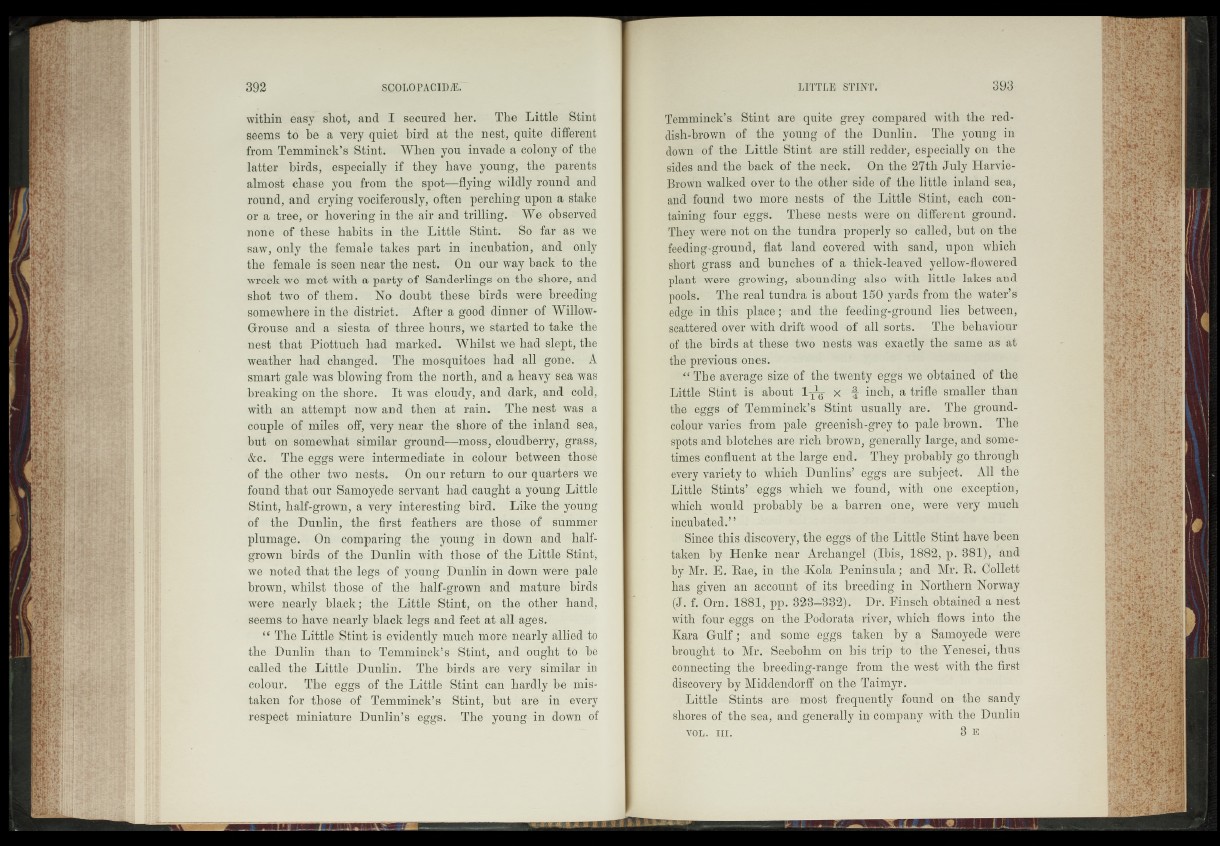
within easy shot, and I secured her. The Little Stint
seems to be a very quiet bird at the nest, quite different
from Temminck’s Stint. When you invade a colony of the
latter birds, especially if they have young, the parents
almost chase you from the spot—flying wildly round and
round, and crying vociferously, often perching upon»a stake
or a tree, or hovering in the air and trilling. H We' observed
none of these habits in the Little Stintr* So far as we
saw, only the female takes part in incubation, and only
the female is seen near the nest. On our way back to the
wreck we met with a' party of Sanderlingsen-ihe shore, afid
shot two of them. ' No doubt these birds were 'breeding
somewhere in the district. i-After ;a good dinner - of- Willow-
Grouse and .a siesta -©L-tHrefe hours, iwe started^ o -take the
nest that Piottuch- had marked.- ■ • Whilst we had slept; ike
weather had changed. The mosquitoes^ had all gone".-* A.
smart gale was-blowing' from the* north, and a heavy sea was
breaking on the shore; It was cloudy, and dark, and cold,
with an attempt- now and then-at;t-rain. Thfe nest-was a
couple of miles off;1 very’near the shore of the inland Sea,
but on somewhat similar ground—moss,’“cloudberry, grass,
&c. The »eggs-were’ intermediate in-iGolo'j©? between th6S&
of the other - two - nests. On our-return to »©hr quarters we
found that our Samoyede'-serv&nt had caught a young Little
Stint, half-grown, avery-idtetesMiiig bird. = Likethb^-Ung
of the Dunlin, the first 'feathers' are those, of - summer
plumage. ‘ On comparing ; the youngs in down and half-
grown birds of the Dunlin w-ith, these of the *<B£tt$e Stint,
-we" noted that the”legs- of -yda-n^ Dunlin indowp were pale
brown, whilst-ihdge of the half-grown and mature-5'birds
were ^early black; tb®* Little Stint, <0® the-ether hand,
seems to have.nearly blacklligs and-1fe@t£at alMgei&b
' “ The Little- Stint is-^evadently much mbre’-nearly allied?©
the Dunlin than- to~ Temminek-s ^Stiht, and oughts©.'be
-called the Lit tier Dunlin. ^The- birds are'* very sMSMar^ih
©olour. Thd e g g s t h e Little«Stint .can hardly be mistaken
for those of Temminck’s- Stint, - but ’ *kr§ ' ifl every
respect miniature Dunlin’'! eggs.- iTheF- young-in down of
Temminck’s Stint are quite grey compared with the rfed-
dish-brown of the young of the Dunlin. The young in
down of the Little Stint are still- redder, especially on the
sides and the back of. the neck. On the 27th July Harvie-
Brown walked over, to the other side of th e ’dittle in-la'nd 'Sea,
and found two-more nests fof the Little Stint,^-each containing
£oua?ieggs. These n e s t s ? o h different ground:.
They Were not. on .the tundra properly So |cM'led^but on the
feeding-ground^ flat land covered with - sand,»upon which
short grass and bunches Cf a thick-leaved'- yellbw-flowered
plant^were ' giowihg, abounding■ ais@';; with - little-:lakis;akid
pdols.'The real tundra is abou^tKM) yards1 fliom the water’s
edge in'-thiSiiplace-; -and—the feeding-ground lies between,
scattered over with drift Wood-i^f all sorted -The behaviour
if1 the birds at these fwo nest's was exactly-the same-as at
th& previous ones." M
■l^hTheiaverage <pize Q#tf&hebweniy egglfJwe* obtained of th%
Little Stint is about x f inch, a trifle smaller than
tbie e§gs of Temminck’s 'StiffbUsually arev The - ground-
colour-"varies fromiJpMfe greenish-.gfeyi-to pale‘brown. The-
spetsvandS blotches aferich, b#®Wn, generally iS g ll and sometimes
confluent :atithe large end."? Htl^probakly go through
every variety to which Dunlins’ oggPmre subjo®#^ All the
LittiV Stintsfeteggs - which we" found, with one excepting
which would ^pi<fbabiy * fee* a barren one, were very much
incubated;.’ ’ -
j-'r!Smce this'disco veryi; •fhe? eggs - of the 'LittK* Stint have bee®
taken by Henke near • Archangel" (Ibis, 'fsfetl’lp* 3&1)V &dd
by* Mr. E. Eae.; in the -Kola JSihihsul-a*; and Mil It. .’Gtdfew
has given! an - a&cota# PfBit's breeding ®i ;Northetn Norway
(fcf. Orn. 1881, pp. Dr-. Ein'sbh 'Obtained* a nest
with fohrieggs on PbdJi’affabii-v&r, which :flbws .'into »the
Kara-Gulf»;- and «ome^gjgfr 'taken* b y a SamOyefie*' Were
teought&to; ‘Mr,wSe^©hin Wflt Ms Mpbfo fffi& ¥feWsei^ thus
boprecting the ibreedihg^fange -from the welt1 With $ke first
discovery by Middendtfrffb@n*lhe 'Talbfiyrt
^pfettle . Stints'-ateb molt frequefftly * found on* the Sandy
shores efjthe sea,bind' generally M-cbtopany with the Dunlin
iS®5)l. iic. 1 1